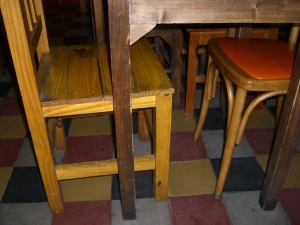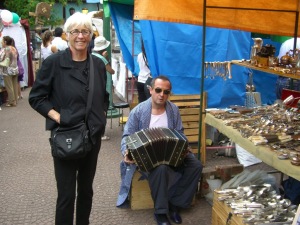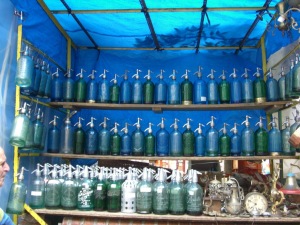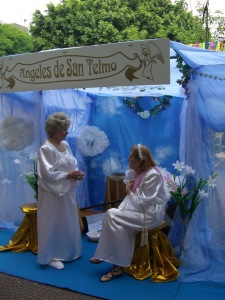 o
o not know why or with what purpose but the vendadores (salesmen/women) dressed up in costumes and had decorated their narrow booths with themes like the Munsters or Frida Kahlo or angels (two ladies floated in white and blue cotton clouds professing to be the angels of San Telmo). After a coffee con leche in a tiny corner bar where a tray of fresh rounds of bread sat cooling, I watched a woman arrive with her baskets of homemade empanadas of “todo un poco” (a little bit of everything) to sell to Sunday strollers. A few blocks away was the indoor market Mercado de San Telmo where displays of fresh fruits and vegetables were art forms among the usual masses of collectibles. One display was an extraordinary collection of matchboxes with everyone from Che Guervera to Elvis and Marilyn on the box covers. (Foto upper left)
not know why or with what purpose but the vendadores (salesmen/women) dressed up in costumes and had decorated their narrow booths with themes like the Munsters or Frida Kahlo or angels (two ladies floated in white and blue cotton clouds professing to be the angels of San Telmo). After a coffee con leche in a tiny corner bar where a tray of fresh rounds of bread sat cooling, I watched a woman arrive with her baskets of homemade empanadas of “todo un poco” (a little bit of everything) to sell to Sunday strollers. A few blocks away was the indoor market Mercado de San Telmo where displays of fresh fruits and vegetables were art forms among the usual masses of collectibles. One display was an extraordinary collection of matchboxes with everyone from Che Guervera to Elvis and Marilyn on the box covers. (Foto upper left)
 blocks and you could probably find the hubcap that disappeared from your car the week before. There would be dolls with no eyes, animals that bark and dance if you squeeze a tiny ball, knitted shawls and sweaters from homespun yarn, endless packets of candy and gum (a little profit is all one needs as a salesman) and fresh off a cart ( as at the Mid-South Fair), you could indulge in great chorizo (sausage) sandwiches covered in a different kind of mustard pickle and salsa golf (catsup mixed with mayo.) You could probably buy the grill
blocks and you could probably find the hubcap that disappeared from your car the week before. There would be dolls with no eyes, animals that bark and dance if you squeeze a tiny ball, knitted shawls and sweaters from homespun yarn, endless packets of candy and gum (a little profit is all one needs as a salesman) and fresh off a cart ( as at the Mid-South Fair), you could indulge in great chorizo (sausage) sandwiches covered in a different kind of mustard pickle and salsa golf (catsup mixed with mayo.) You could probably buy the grill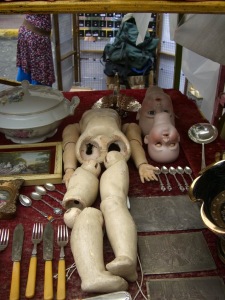 as well for the right price. Anything was for sale. But a serious shopper meandered toward the serious antique havens on Tristan Navaja street. I longed for the ornate Majorca pieces – a pedestal covered in three-dimensional roses and flowers that cost a few thousand dollars, the price never went down, just up so I let that pass; Majorca plates not to eat upon but to hang on a wall, odd Majorca ceramic pieces to hold asparagus or artichokes. Exciting pieces. Also ornately carved silver mate cups, sets of French Chiffolet silverware, old lace tablecloths, or sets of red crystal glasses, the finer things in life. You might sit in a corner bar and watch the people and the thieves at work while eating a media luna with café cortado (a tiny cup of strong espresso sweetened.) And you wondered if the “cuida coche” or car watcher you just gave a few pesos to when you parked is really paying attention to your car. This was Uruguay. In Argentina during my cafe cortado I watched a scraggly type set himself up to break into some unawares car.
as well for the right price. Anything was for sale. But a serious shopper meandered toward the serious antique havens on Tristan Navaja street. I longed for the ornate Majorca pieces – a pedestal covered in three-dimensional roses and flowers that cost a few thousand dollars, the price never went down, just up so I let that pass; Majorca plates not to eat upon but to hang on a wall, odd Majorca ceramic pieces to hold asparagus or artichokes. Exciting pieces. Also ornately carved silver mate cups, sets of French Chiffolet silverware, old lace tablecloths, or sets of red crystal glasses, the finer things in life. You might sit in a corner bar and watch the people and the thieves at work while eating a media luna with café cortado (a tiny cup of strong espresso sweetened.) And you wondered if the “cuida coche” or car watcher you just gave a few pesos to when you parked is really paying attention to your car. This was Uruguay. In Argentina during my cafe cortado I watched a scraggly type set himself up to break into some unawares car.
After visiting these “flea markets”, most Argentine and Uruguayan families traditionally go to their favorite parillada for asado (Latin beef barbecue) – a good steak, chivito (goat), or grilled trucha (trout). Mozos in black vests and long trousers, towels tossed over their shoulder or arm, hover as if you were someone important, stacking plates of food like a balancing act from Circus de Soliel. Mozos know the regulars from the tourists and the tight-wads from the tippers.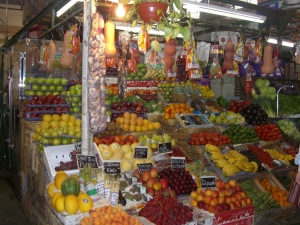 Typical Feria
Typical Feria
In Buenos Aires, we lunched (almuerzo) at the Estilo Campo (see photo below) in the port area near the new hotel called Faena (which is a rededicated “factory” or group of silos owned by a man named Faena). Really a faena is cornmeal pizza – cooked in the same size as normal pizza but with no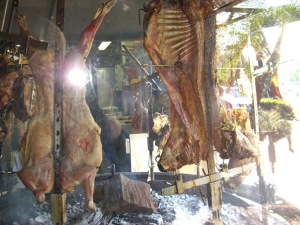 thing on it – you can buy an instant mix – and in Uruguay it’s served under a regular pizza – not American style – but one covered in tomato sauce only.) The hotel is too fancy for comestible faenas but maintains the brick facade of the silos and factory it once was, while inside is a dark bordello – tango colors of wine and white , gold goose Napoleon chairs, and boys vested in black attend your check-in needs. Reminded me of L’Hotel in Paris.
thing on it – you can buy an instant mix – and in Uruguay it’s served under a regular pizza – not American style – but one covered in tomato sauce only.) The hotel is too fancy for comestible faenas but maintains the brick facade of the silos and factory it once was, while inside is a dark bordello – tango colors of wine and white , gold goose Napoleon chairs, and boys vested in black attend your check-in needs. Reminded me of L’Hotel in Paris.
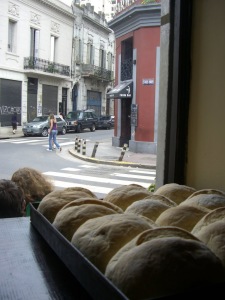
Fresh from the oven bread in a typical bar.
I was stuffed for the rest of the day after following salmon empanadas with grilled local fish and then almendrada (almond) ice cream in thick squares. Most families afternoon at huge parks to “toma sol” or “juega futbol” or roller blade with their children, to walk through the many manicured beds of roses or to kayak down the river. Very Seurat. There are even wooden beds scattered throughout the park for sunbathing or picnicking. Most men watch the elimination rounds of soccer on their modern gadgets.
My stop was brief in Buenos Aires en route to Ushuaia but I felt at home because the language carries the sounds I love and the people are open and cheerful. I’m so happy to be speaking Spanish again and understanding what those around me are saying. Not like traveling in Russia or Iceland where I moved in vocal silence, not able to decipher a thing. But here in Argentina so near Uruguay I could feel the embrace of the life I loved, an embrace equal only to those hugs from Giorgianna and Nutie, who raised me and my children and whom I think of often.
More Notes from the Plane  Ushuaia, Argentina
Ushuaia, Argentina
From Buenos Aires to Ushuaia is about as long a flight as from Memphis to San Francisco, except you have to stumble through Aeroparque, the local airport, and no one (all the agents seem high school young) knows anything about where you are supposed to be, much less what gate you depart from – until about 10 minutes before boarding the flight. (This was also a nightmare in Mexico City’s huge huge fancy airport where it might be a kilometer to your gate.) Surprise. You are at gate 12 and in 5 seconds there is a line as long as tryouts for American Idol. Don’t dilly dally at the capuccino and media lunas (croissants made with grasa, not butter, but sliced , then buttered and filled with great cheese and thin slice of ham.) If I was Pablo Neruda, I’d write an ode to Latin America airports and with “carino” to “media lunas” of Uruguay. (They slip in quality outside Uruguayan borders.)
Ushuaia, Ushuaia. Ush (oosh) ua (ou-wa) ia (ya). I can’t even say it – it’s like trying to talk with your lips frozen. It’s an Indian name (from the Onas tribe – mostly killed off today) And I believe Ushuaia, which is the southernmost point for anything landing in Argentina or Chile, is one frozen urban site with bergs. All I have on is a cashmere sweater and a cotton Gap jacket. But in the long duffle bag rests a wardrobe of defense against the cold – required for the upcoming trip to Antarctica setting sail tomorrow after a promised Argentina barbecue (think lamb or goat spread eagle on a square frame – cooked slowly without the constant saucing as we Delta folk insist on our pork and beef barbecues.) Probably the chefs will have on gaucho pants and chanelas (flip flops), with a silver knife (cuchillo) stuck in a woven belt tied in a sash around his waist. That’s the way they do it in Uruguay, and Argentina is about the same, except in Uruguay the meat of choice at an asado (barbecue) is beef or “chancho” (pork.) We’ll see.
Note: Eliminating tribes of Indians appears often in Latin American history. Uruguay was home to the Charrua Indians, who were killed off at a barbecue given by one of the famous presidents in the 1800s. By luck, there was one or two Charruas travelling on exhibit in France (remember Buffalo Bill was popular in Europe for his exhibition of savage American Natives) and therefore the line wasn’t completely eliminated and has now been blended into French heritage.

